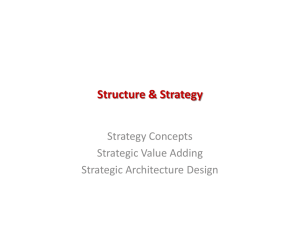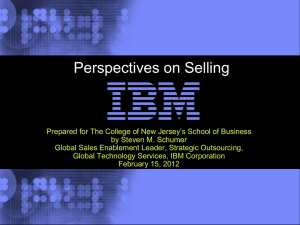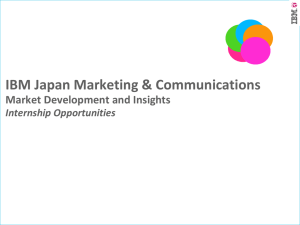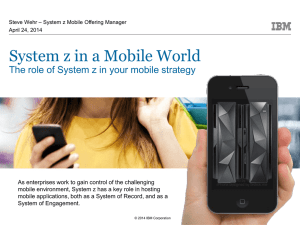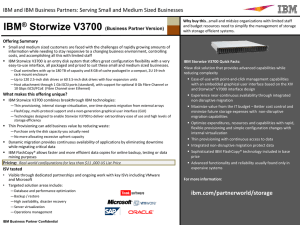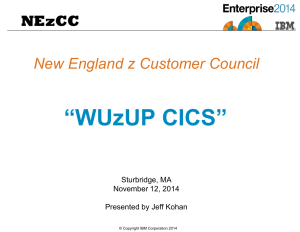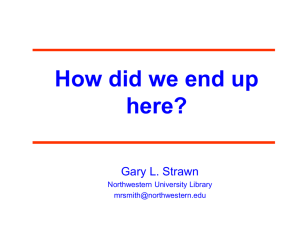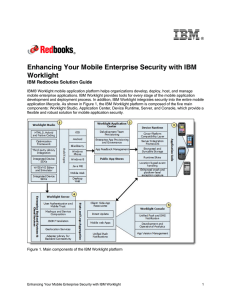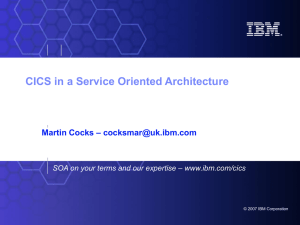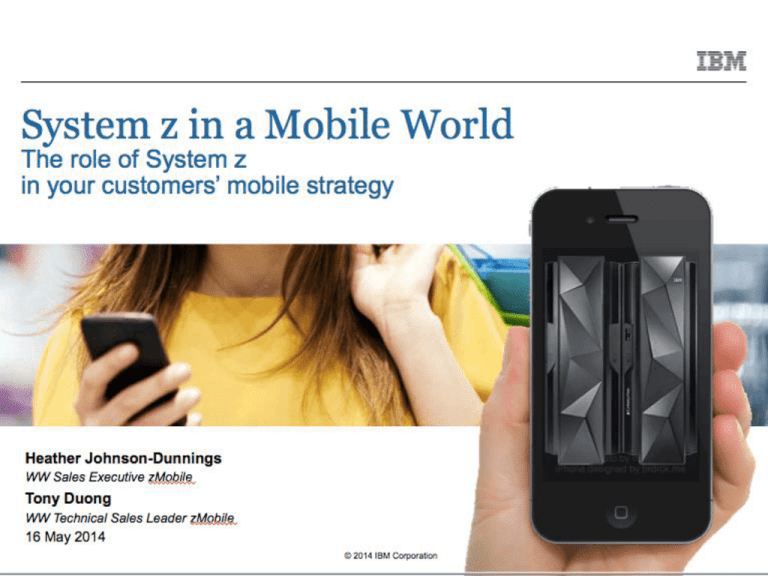
System z in a Mobile World
The role of System z
in your customers’ mobile strategy
© 2014 IBM Corporation
Five mobile trends with significant implications for the Enterprise
Mobile enables the
Internet of Things
Mobile is primary
91% of mobile users keep
their device within arms
reach 100% of the time
Global Machine-to-machine
connections will increase
from 2 billion in 2011 to 18
billion at the end of 2022
Mobile must create a
continuous brand
experience
Insights from mobile
data provide new
opportunities
90% of users use multiple
screens as channels come
together to create
integrated experiences
75% of mobile shoppers
take action after receiving a
location based messages
Mobile is about transacting
96% year to year increase in mobile cyber
1
Monday sales between
2012 and 2011
IBM MobileFirst Offering Portfolio
Industry Solutions
Banking
Insurance
Retail
Transport
Telecom
Government
Healthcare
Automotive
Strategy & Design Services
Application & Data Platform
Management
Devices
Security
Network
Cloud & Managed Services
2
Analytics
Servers
Development & Integration Services
IBM & Partner Applications
IBM MobileFirst Offering Portfolio
Recommend
run on z
Industry Solutions
Banking
Strategy & Design Services
Mobile
Strategy and
Planning
Services
Retail
GT Software
Ivory Service
Architect
Worklight
Telecom
Government
IBM & Partner Applications
Rational Tools
for zApplication
(RDz).
&MessageSight
Data Platform
UrbanCode
Deploy
Endpoint
Manager.
Fiberlink
Maas360
Management
Devices
Codename:
BlueMix
Transport
Healthcare
IBM Remote
Collaboration -Portal,
Connections,
Notes traveller
ISAM
Servers
Network DataPower
3
Mobile
Application
Management
Services
COGNOS
Mobile
Analytics
Security zSecure
Cloud & Managed Services
Codename:
BlueMix
TeaLeaf
AppScan
zOS Connect
Automotive
Enterprise
Services for
Managed
Mobility
Development & Integration Services
IBM
Interactive
Insurance
Enabling the Composable Business access to z/OS assets
IBM WebSphere Liberty z/OS Connect
Capture new opportunities from existing
enterprise investments
Provide auditing and chargeback for cloud,
mobile and web based requests
z/OS Connect
Simplify mobile and cloud connectivity to z/OS
applications and data
Batch
CICS
IMS
Reduce development time and cost via industry
standard interface to enterprise assets
What’s new in IBM WebSphere Liberty z/OS Connect
Secure REST based connectivity to enterprise applications and data
Tight integration with System z and z/OS qualities of service
Delivered as a feature of the Liberty Profile in WebSphere, CICS and IMS
IBM Confidential until IMPACT
System z addresses Enterprise mobile development and delivery challenges
IBM Worklight Studio and RDz
Fragmentation and developing for multiple
mobile platforms
• Seamless integration with z data
and transactions.
• Highly fragmented set of devices, platforms,
languages, and tools complicates
development, test, and operations
• Device runtime provides mobile
device independence.
Accelerated time to market requirements
System z Scalability
• Accelerated development demands instant
provisioning of development servers.
• System z Linux cloud enables rapid
provisioning of Worklight servers.
• Spikey mobile traffic demands highly
scalable cloud-based infrastructures, for
both SoE and SoR.
• z/OS is the leader in transaction
processing and easily scalable to
handle workload increases.
Connecting apps with existing
enterprise systems
z/OS is mobile enabled
• z/OS subsystems are mobile-ready,
with consumability enhancements
planned. Eg: MongoDB API for DB2
• End to end mobile security.
• High-performance access from z/Linux
• Apps typically need to leverage existing
enterprise services, which must be made
mobile-consumable, and remain secure.
• Enterprise systems must be able to instantly
provision new services and environments.
5
IBM Worklight overview
Worklight Studio
The most complete, extensible environment with
maximum code reuse and per-device optimization
Worklight Server
Unified notifications, runtime skins, version
management, security, integration and delivery
←
Worklight Device Runtime Components
Extensive libraries and client APIs that expose and
interface with native device functionality
Worklight Console
A web-based console for real-time analytics and
control of your mobile apps and infrastructure
6
CICS Mobile demonstration with iPad and iPhone for Insurance Claim
http://www.youtube.com/watch?v=6TkQ9PzeevQ
Mobilize the Mainframe
http://www.youtube.com/watch?v=zc2fCvqNv70
Mike Lavaca narrating EGUI Demo:
Demonstrating the before and after looks of the CICS catalog manager example
sample application. From using 3270 emulator to running as a Worklight mobile
application. A walk through of the transformed and extended mobile client
features and functionalities. Brief highlights of Worklight MBS as well as
Cordova APIs.
THANK YOU
8
Backup
System z Unique Characteristics to support
Mobile Applications
Easy-to-consume APIs from CICS, DB2, IMS allow you to leverage your
investment in z/OS transactions to quickly add a mobile channel.
z/OS enables massive and simple scalability in a single footprint, to handle the
workload of millions of devices and sensors
Worklight security integrates with z/OS security providing end-to-end security
and data privacy for mobile apps.
z/OS Workload Management ensures your crucial applications remain
responsive during sharp spikes in demand.
Low-latency access to critical enterprise data. Mobile usage patterns favor short, read-only data
requests (Users check account balances) So fast access to operational data, with low latency, is key. The mainframe
offers exceptional I/O with dedicated hardware I/O processors. This reduces latency, which increases mobile app
response times.
Business Resiliency for critical mobile apps
“70% of mobile applications touch a mainframe system”
Infrastructure matters for mobile applications. The
System z platform’s scalability, security, and
resilience can enhance critical mobile applications.
10
Why run Worklight Server on System z Linux?
For the same reasons you run web apps there for over a decade:
Co-location of the Worklight server application with data and transactions on z/OS
reduces the latency of access to z/OS data. Hipersockets provides the lowest latency
communication between Worklight apps and z/OS SOR. Hipersockets eliminates the need to encrypt traffic between
Worklight and z/OS.
Availability and scalability of z/Linux as an environment for both Worklight dev/test
and production.
Hardware encryption speeds SSL applications
All the traditional advantages of consolidating multiple distributed servers onto
z/Linux -- Reduce data center footprint, WAS software license savings, simpler
management, energy savings.
We recommend running Worklight Server in System
z Linux for data-rich applications that will heavily
leverage data and transactions from z/OS.
See this wiki for more rationale for WL on z.
11
CICS Mobile Enablement (CICS TS 5.1)
NEW -- Run the WAS Liberty profile
in CICS to give JSON capabilities to
CICS Java apps.
z/Linux
IBM z/OS
IBM Worklight
Server
WAS Liberty
Profile
HTTP Adapter
CICS TS 5.1
JSON
CICS
Java App
CICS Mobile
Feature Pack
JSON
CICS
COBOL,
C, PL/1
App
Mobile
Devices
CICS
Resources
12
Tiered mobile environment
Mobile Devices
Systems of Engagement
zOS Connect
Systems of Record
Mobile Enterprise Application
Platform (MEAP)
Blackberry
Protocol
conversion
Windows
Phone
Mobile services:
Push, Analytics
13
IMS
WebSphere AS
DB2
Analytics
JSON
Back-end
connectivity
SOAP
XML
JSON
MQ
HTTP
SERVICES
Android
CICS
Security
iOS
IMS Mobile Enablement
Mobile
Devices
z/Linux
IMS SOAP Gateway
IBM Worklight
Server
Web / Desktop
z/OS
HTTP Adapter
IMS Explorer for Dev
SQL Adapter
IMS Explorer for Admin
Connect API
Web-enabled IMS apps
14
Transaction
Manager
IMS
Application
IMS Universal Driver
SQL
IMS
Connect
Database
Manager
ISPF
IMS DB
DB2 NoSQL (MongoDB) JSON Support
The best of both worlds – NoSQL
agility and flexibility built on the
trusted foundation of DB2
Applications
Java
– Write applications using Mongo APIs to
access data on DB2.
– Flexible schemas allow rapid delivery of
applications
Preserve traditional DBMS Capabilities, leverage
existing skills and tools:
– Multi-statement Transactions
– Management/Operations
– Security
– Scale, performance and high availability
Extend with Advanced features (future)
– Temporal semantics
– Full Text search
– Multi-collection joins
– Combine with Enterprise RDBMS data
Implementation leverages open source
community drivers.
Available in DB2 for z/OS V10 now.
In DB2 for z/OS V11 expected June 2014.
PHP
NodeJS
BSON Wire Protocol
NoSQL JSON Wire
Listener
JSON API
JSON CLP
JDBC Driver
DRDA
JSON
JSON
JSON
JSON
JSON
JSON
15
DB2 Database
Indexing of
individual JSON
members
IBM z/OS Connect
Batch
WAS Liberty z/OS
Security / Auditing /WOLA
Metering
WOLA direct
DB2
RESTful
BlueMix
CloudOE
Java
CloudOE
RESTful
Javascript
Mobile/
APIM
RESTful
zOS
C
O
N
N
E
C
T
Data binding
conversion/routing
CICS
WOLA
WOLA Link Server
Task
DLI
WOLA
CICS
Programs
VSAM
IMS
WOLA over
OTMA
z/OS Connect
A service that encapsulate calling z/OS target applications using REST calls.
z/OS Connect will support JSON payloads for calls from external cloud or
mobile-based clients and will enable the conversion of the payload to the target
program's expected format. It will also provide the response payload conversion
from a byte array into JSON format before returning the response to the caller.
IMS dependent
regions
Legal Disclaimer
• © IBM Corporation 2013. All Rights Reserved.
• The information contained in this publication is provided for informational purposes only. While efforts were made to verify the completeness and accuracy of the information contained
in this publication, it is provided AS IS without warranty of any kind, express or implied. In addition, this information is based on IBM’s current product plans and strategy, which are
subject to change by IBM without notice. IBM shall not be responsible for any damages arising out of the use of, or otherwise related to, this publication or any other materials. Nothing
contained in this publication is intended to, nor shall have the effect of, creating any warranties or representations from IBM or its suppliers or licensors, or altering the terms and
conditions of the applicable license agreement governing the use of IBM software.
• References in this presentation to IBM products, programs, or services do not imply that they will be available in all countries in which IBM operates. Product release dates and/or
capabilities referenced in this presentation may change at any time at IBM’s sole discretion based on market opportunities or other factors, and are not intended to be a commitment to
future product or feature availability in any way. Nothing contained in these materials is intended to, nor shall have the effect of, stating or implying that any activities undertaken by
you will result in any specific sales, revenue growth or other results.
• If the text contains performance statistics or references to benchmarks, insert the following language; otherwise delete:
Performance is based on measurements and projections using standard IBM benchmarks in a controlled environment. The actual throughput or performance that any user will
experience will vary depending upon many factors, including considerations such as the amount of multiprogramming in the user's job stream, the I/O configuration, the storage
configuration, and the workload processed. Therefore, no assurance can be given that an individual user will achieve results similar to those stated here.
• If the text includes any customer examples, please confirm we have prior written approval from such customer and insert the following language; otherwise delete:
All customer examples described are presented as illustrations of how those customers have used IBM products and the results they may have achieved. Actual environmental costs
and performance characteristics may vary by customer.
• Please review text for proper trademark attribution of IBM products. At first use, each product name must be the full name and include appropriate trademark symbols (e.g., IBM
Lotus® Sametime® Unyte™). Subsequent references can drop “IBM” but should include the proper branding (e.g., Lotus Sametime Gateway, or WebSphere Application Server).
Please refer to http://www.ibm.com/legal/copytrade.shtml for guidance on which trademarks require the ® or ™ symbol. Do not use abbreviations for IBM product names in your
presentation. All product names must be used as adjectives rather than nouns. Please list all of the trademarks that you use in your presentation as follows; delete any not included in
your presentation. IBM, the IBM logo, Lotus, Lotus Notes, Notes, Domino, Quickr, Sametime, WebSphere, UC2, PartnerWorld and Lotusphere are trademarks of International
Business Machines Corporation in the United States, other countries, or both. Unyte is a trademark of WebDialogs, Inc., in the United States, other countries, or both.
• If you reference Adobe® in the text, please mark the first use and include the following; otherwise delete:
Adobe, the Adobe logo, PostScript, and the PostScript logo are either registered trademarks or trademarks of Adobe Systems Incorporated in the United States, and/or other countries.
• If you reference Java™ in the text, please mark the first use and include the following; otherwise delete:
Java and all Java-based trademarks are trademarks of Sun Microsystems, Inc. in the United States, other countries, or both.
• If you reference Microsoft® and/or Windows® in the text, please mark the first use and include the following, as applicable; otherwise delete:
Microsoft and Windows are trademarks of Microsoft Corporation in the United States, other countries, or both.
• If you reference Intel® and/or any of the following Intel products in the text, please mark the first use and include those that you use as follows; otherwise delete:
Intel, Intel Centrino, Celeron, Intel Xeon, Intel SpeedStep, Itanium, and Pentium are trademarks or registered trademarks of Intel Corporation or its subsidiaries in the United States and
other countries.
• If you reference UNIX® in the text, please mark the first use and include the following; otherwise delete:
UNIX is a registered trademark of The Open Group in the United States and other countries.
• If you reference Linux® in your presentation, please mark the first use and include the following; otherwise delete:
Linux is a registered trademark of Linus Torvalds in the United States, other countries, or both. Other company, product, or service names may be trademarks or service marks of
others.
• If the text/graphics include screenshots, no actual IBM employee names may be used (even your own), if your screenshots include fictitious company names (e.g., Renovations, Zeta
Bank, Acme) please update and insert the following; otherwise delete: All references to [insert fictitious company name] refer to a fictitious company and are used for illustration
purposes only.


